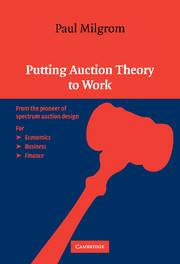PART I - THE MECHANISM DESIGN APPROACH
Published online by Cambridge University Press: 05 June 2012
Summary
The five chapters of Part I apply mechanism design theory and related methods to problems of auction design. We begin with informal descriptions of the main concepts of mechanism design theory. Although these descriptions correspond closely to the formal ones, they conceal technical details that are occasionally important, so the mathematical development is indispensable for a full understanding of the theory.
Mechanism design theory distinguishes sharply between the apparatus under the control of the designer, which we call a mechanism, and the world of things that are beyond the designer's control, which we call the environment. A mechanism consists of rules that govern what the participants are permitted to do and how these permitted actions determine outcomes. An environment comprises three lists: a list of the participants or potential participants, another of the possible outcomes, and another of the participants' possible types – that is, their capabilities, preferences, information, and beliefs.
In a political mechanism model, the participants could be legislators, and an outcome the set of bills that are enacted. Or the participants could be voters, and the outcome a set of elected officials. The mechanism analyst might investigate how a particular legislative process affects the likelihood of stalemate or how the electoral system distorts choices by politicians concerned with reelection. In economic mechanism models, the participants could be workers, or the members of a family, or departmental managers.
- Type
- Chapter
- Information
- Putting Auction Theory to Work , pp. 35 - 44Publisher: Cambridge University PressPrint publication year: 2004



